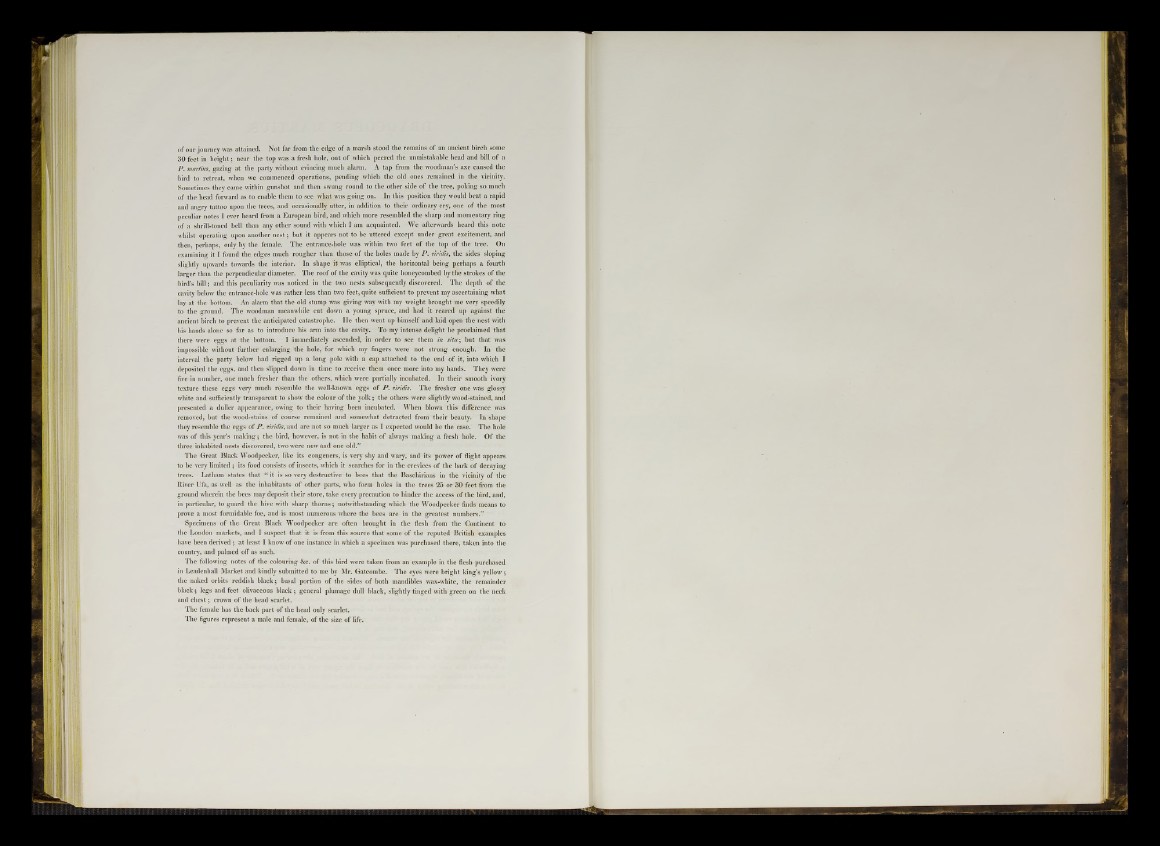
of our journey was attained. Not far from the edge of a marsh stood the remains of an ancient birch some
30 feet in height; near the top was a fresh hole, out of which peered the unmistakable head and bill of a
P. martius, gazing at the party without evincing much alarm. A tap from the woodman’s axe caused the
bird to retreat, when we commenced operations, pending which the old ones remained in the vieiuity.
Sometimes they came within gunshot and then swung round to the other side of the tree, poking so much
of the head forward as to enable them to see what was going on. In this position they would beat a rapid
and angry tattoo upon the trees, and occasionally utter, in addition to their ordinary cry, one of the most
peculiar notes I ever heard from a European bird, and which more resembled the sharp and momentary ring
of a shrill-toned bell than any other sound with which I am acquainted. We afterwards heard this note
whilst operating upon another nest; but it appears not to be uttered except under great excitement, and
then, perhaps, only by the female. The entrance-hole was within two feet of the top of the tree. On
examining it I found the edges much rougher than those of the holes made by P. viridis, the sides sloping
slightly upwards towards the interior. In shape it was elliptical, the horizontal being perhaps a fourth
larger than the perpendicular diameter. The roof of the cavity was quite honeycombed by the strokes of the
bird’s bill; and this peculiarity was noticed in the two nests subsequently discovered. The depth of the
cavity below the entrance-hole was rather less than two feet, quite sufficient to prevent my ascertaining what
lay at the bottom. An alarm that the old stump was giving way with my weight brought me very speedily
to the ground. The woodman meanwhile cut down a young spruce, and had it reared up against the
ancient birch to prevent the anticipated catastrophe. He then went up himself and laid open the nest with
his hands alone so far as to introduce his arm into the cavity. To my intense delight he proclaimed that
there were eggs at the bottom. I immediately ascended, in order to see them in situ; but that was
impossible without further enlarging the hole, for which my fingers were not strong enough. In the
interval the party below had rigged up a long pole with a cap attached to the end of it, into which I
deposited the eggs, and then slipped down in time to receive them once more into my hands. They were
five in number, one much fresher than the others, which were partially incubated. In their smooth ivory
texture these eggs very much resemble the well-known eggs of P. viridis. The fresher one was glossy
white and sufficiently transparent to show the colour of the yolk; the others were slightly wood-stained, and
presented a duller appearance, owing to their having been incubated. When blown this difference was
removed, but the wood-stains of course remained and somewhat detracted from their beauty. In shape
they resemble the eggs of P. viridis, and are not so much larger as I expected would be the case. The hole
was of this year’s making; the bird, however, is not in the habit of always making a fresh hole. Of the
three inhabited nests discovered, two were new and one old.”
The Great Black Woodpecker, like its congeners, is very shy and wary, and its power of flight appears
to be very limited ; its food consists of insects, which it searches for in the crevices of the bark of decaying
trees. Latham states that “ it is so very destructive to bees that the Baschirians in the vicinity of the
River Ufa, as well as the inhabitants of other parts, who form holes in the trees 25 or 30 feet from the
ground wherein the bees may deposit their store, take every precaution to hinder the access of the bird, and,
in particular, to guard the hive with sharp thorns; notwithstanding which the Woodpecker finds means to
prove a most formidable foe, and is most numerous where the bees are- in the greatest numbers.”
Specimens of the Great Black Woodpecker are often brought in the flesh from the Continent to
the London markets, and I suspect that it is from this source that some of the reputed British examples
have been derived; at least I know of one instance in which a specimen was purchased there, taken into the
country, and palmed off as such.
The following notes of the colouring &c. of this bird were taken from an example in the flesh purchased
in Leadenhall Market and kindly submitted to me by Mr. Gatcombe. The eyes were bright king’s yellow;
the naked orbits reddish black; basal portion of the sides of both mandibles wax-white, the remainder
black; legs and feet olivaceous black; general plumage dull black, slightly tinged with green on the neck
and chest; crown of the head scarlet.
The female has the back part of the head only scarlet.
The figures represent a male and female, of the size of life.